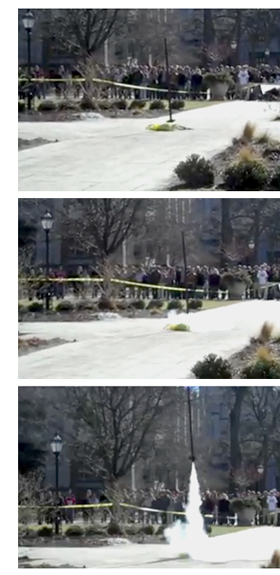| Sun | Mon | Tue | Wed | Thu | Fri | Sat |
|---|---|---|---|---|---|---|
| 1 | 2 | 3 | 4 | 5 | ||
| 6 | 7 | 8 | 9 | 10 | 11 | 12 |
| 13 | 14 | 15 | 16 | 17 | 18 | 19 |
| 20 | 21 | 22 | 23 | 24 | 25 | 26 |
| 27 | 28 | 29 | 30 | 31 |
CATEGORIES
RECENT ENTRIES
BLOG ROLL
A rocket's maroon glare, bursting with flair
 Two new engineering-focused RSOs launch a 7-foot, 6-inch rocket on the University's main quads.
Two new engineering-focused RSOs launch a 7-foot, 6-inch rocket on the University's main quads.
Friday was brisk, sunny, and a little windy, a welcome change from the last few frigid weeks, and no, not ideal rocket-launching weather but, hey, what are you gonna do? The Facebook page you made this week brought the 150 or so excited students and administrators standing around the center of the main quad, which is cordoned off for safety reasons that will soon prove academic, and are you gonna let a little wind stop you? Can you not launch your rocket?
Please.
At the center of campus stands the projectile attracting all the attention, though it's not quite the beauty the Facebook page described, "a 7'6" tall rocket powered by a cluster of three engines" evoked. (I was thinking a small-scale version of those Cold War monsters with the benign names, like Atlas or Titan.)
It is a tall and thin black pipe with a red-stripped snub nose, standing on a small platform supported by bags of rock salt. A small-by-comparison girl wearing a big backpack holds the rocket upright as 12:25 p.m. and lift-off ticks closer.
The fledgling Engineering Society is responsible for the launch, along with the months-older Student Organization of Aeronautics and Robotics and funding in part from Student Government. A boy from the Engineering Society stands near the rocket and says over the entirely appropriate PA system, "See? There is engineering at the University of Chicago."
The crowd is eager—besides the annual Polar Bear Run, the quad hasn't seen anything this crazy in recent memory—though not all for the best reasons; someone in the crowd told a friend, "The mere fact that something could go wrong makes me want to stay." But the group's organizers had assured people, via the event's Facebook page, that safety precautions had been taken. "This is an official ORCSA event planned in coordination with the Facilities and Safety offices. There will be a safety officer at the launch. Rocket altitude is within FAA limits and descent is controlled by a parachute system. Nobody is going to die, we swear."
The student holding the rocket steps away, and it slumps towards the administration building. The audience laughs. She sets it upright again, and it slumps the other way, prompting more laughter. But apparently it's fine, and the launch-pad is clear. All eyes are on the rocket.
A cry goes up, and the huge ring of people picks up the countdown.
"7! 6! 5! 4! 3! 2! 1!—"
Nothing. The expectant audience breathes out, with a chuckle.
Foom ssssssseeoohhhh! Smoke puffs out over the concrete as the rocket jumps up into the air. It arcs up, fizzing and listing and now over the crowd—will it hit someone? It's three stories up! As high as Rosenwald! How high will it go? And, it—sputters, and coughs, and oh well, dips down into a tree 25 yards from where it launched, splitting in half on one of the branches. A little parachute deploys and the lower half drifts the twenty feet back to terra firma.
Watch the video on Facebook
Everyone claps and the crowd heads off, while the students in the group congratulate each other by the launch-pad. One of the group, Arindrima Datta, '14, tells me the launch was fine, but two of the engines failed. Lexi Goldberger, '14, says the group expected the rocket would fly up five or 600 feet, but estimated that it reached "150, maybe 100 feet."
They tell me the rocket has no name, though "UCHI ES SOAR" is written on the side to commemorate the school, the Engineering Society, and the Aeronautics and Robotics RSO. They also say it was built based on a design from the internet in the basement of Pierce Hall over 3 or 4 meetings, that the Physics Department pitched in with a power generator to ignite the rockets, and that the groups have big plans in store, despite the fact that they are two and five months old, respectively.
Already being planned are a homemade cyclotron (as in a particle accelerator), a 3D-printer, something having to do with (undoubtedly awesome) robotics, a hoverboard project that is Goldberger's own, and a moon buggy that the Engineering Society will enter into a NASA-sponsored competition.
The students in the two RSOs seem to be mostly first-years and excited about engineering at the U of C. Though the school has no official engineering program, that didn't sway Datta from attending; she said she "came to Chicago knowing that you can do anything and start any RSO."
Asher Klein, '11
February 23, 2011
